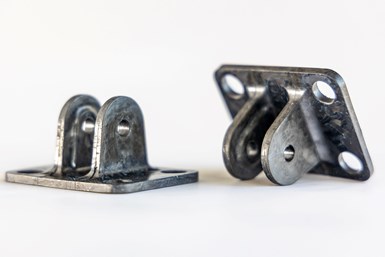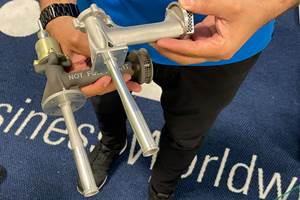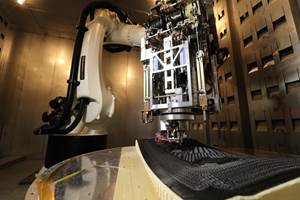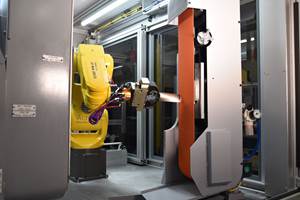9T Labs, Purdue Partner to Advance Composite Use in Structural Aerospace Applications
The collaboration is working to define a new composite manufacturing standard that enables users to produce structural composite parts as easily as metal parts.
9T Labs is collaborating with Purdue University to research and test the potential of manufacturing structural aerospace composite applications at scale with 9T Labs’ additive fusion technology (AFT). This partnership with Purdue, one of the leading engineering universities in the U.S., is a first-of-its-kind U.S. collaboration for 9T Labs, which has expertise in digital, automated and cost-competitive serial production of continuous fiber components.
This hybrid solution combines high-resolution additive manufacturing (AM) with the speed of bulk molding compound (BMC) overmolding to automate manufacturing. It is being developed to offer a cost-competitive option versus the traditional production of aluminum aerospace parts. 9T Labs says its approach to continuous fiber, 3D printed preform parts has already shown great promise in the transportation, medical and robotics industries, among others.
Purdue University’s Composite Manufacturing and Simulation Center (CMSC) in West Lafayette, Indiana, provides the necessary tools and resources to analyze, simulate and test the performance of composites. 9T Labs and Purdue worked collaboratively to develop the application workflow to efficiently engineer and manufacture high-performance parts using BMC chips and continuous-fiber 3D printed preforms. Initial testing shows that customized, continuous-fiber hybrid parts can be digitally designed, 3D printed and co-molded with BMC materials, ensuring performance at only a fraction of the usual cost of continuous fiber materials.
“Traditional composite manufacturing is expensive, wasteful and limited in its geometric freedom, particularly for small-sized applications,” says Yannick Willemin, head of marketing and business development, 9T Labs. “We are defining a new composite manufacturing standard that allows us to produce structural composite parts as easily as metal parts. Our new partnership with Purdue University is a meaningful step toward making this technology more broadly available and accessible within the next 12-18 months.”
The origins of this partnership trace back to when 9T Labs’ CEO and Co-founder, Martin Eichenhofer, learned of John L. Bray distinguished professor of Engineering at Purdue University, Dr. R. Byron Pipes', work on composites during his doctoral studies. “When I heard about the new Composite Manufacturing and Simulation Center led by Dr. Byron Pipes, I reached out to him to discuss what we were doing at 9T Labs,” Eichenhofer says. “His curiosity was piqued and we discovered an opportunity to work together on advanced thermoplastic composites.”
Beyond the practical applications and potential that the AFT hybrid solution brings to multiple important industries, there are strong economic and sustainability benefits to using this technology. “We’ve chosen to collaborate with 9T Labs because we believe that their development of AFT and their novel hybrid approach is the future of the composite manufacturing industry,” Dr. Pipes says.
The combination of zero-waste approach, the possibility to recycle thermoplastics, and the positive impact on part performance being at least 50% lighter than the metal benchmarks makes AFT a very attractive standard of manufacturing.
“This technology we are developing with 9T labs for molding BMC material systems with a relatively small fraction of continuous-fiber printed preforms offers significant potential to enhance the strength performance of molded components without compromising manufacturing rates,” says Dr. Eduardo Barocio, assistant director for additive manufacturing at Purdue.
9T Labs is at the forefront of a completely new field of composite manufacturing that has real- world implications for structural and processing simulation, material compositions and characterization, experimental testing, and application engineering. “This new partnership with Purdue is an additional step toward building a consortium of partners from academia and industry to penetrate the market and accelerate the adoption of AFT and composite materials for a broad application field,” Eichenhofer says.
- Read about how 9T Labs’ deposition process places continuous carbon fiber only where necessary to save material, reduce waste, and more precisely control the structure of preform composites.
- In this episode of The Cool Parts Show, AM editors explore a new way of manufacturing a bracket for a helicopter door hinge, and similar small parts today made from metal.
Related Content
Qualification Today, Better Aircraft Tomorrow — Eaton’s Additive Manufacturing Strategy
The case for additive has been made, Eaton says. Now, the company is taking on qualification costs so it can convert aircraft parts made through casting to AM. The investment today will speed qualification of the 3D printed parts of the future, allowing design engineers to fully explore additive’s freedoms.
Read MoreHow 3D Printing Will Change Composites Manufacturing
A Q&A with the editor-in-chief of CompositesWorld explores tooling, continuous fiber, hybrid processes, and the opportunities for smaller and more intricate composite parts.
Read MoreNew Zeda Additive Manufacturing Factory in Ohio Will Serve Medical, Military and Aerospace Production
Site providing laser powder bed fusion as well as machining and other postprocessing will open in late 2023, and will employ over 100. Chief technology officer Greg Morris sees economic and personnel advantages of serving different markets from a single AM facility.
Read MoreAircraft Engine MRO: How Additive Manufacturing Plus Robotic Finishing Will Expand Capacity for Blade Repair
AM offers the chance to bring fast, automated processing to individualized, part-by-part restoration of turbomachinery. A cell developed by Acme Manufacturing and Optomec is able to automatically repair 85,000 unique aircraft engine blades per year.
Read MoreRead Next
3D Printing Brings Sustainability, Accessibility to Glass Manufacturing
Australian startup Maple Glass Printing has developed a process for extruding glass into artwork, lab implements and architectural elements. Along the way, the company has also found more efficient ways of recycling this material.
Read More4 Ways the Education and Training Challenge Is Different for Additive Manufacturing
The advance of additive manufacturing means we need more professionals educated in AM technology.
Read MoreHybrid Additive Manufacturing Machine Tools Continue to Make Gains (Includes Video)
The hybrid machine tool is an idea that continues to advance. Two important developments of recent years expand the possibilities for this platform.
Read More






















